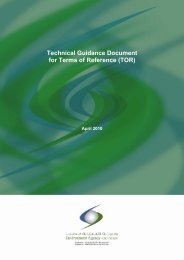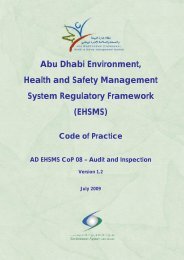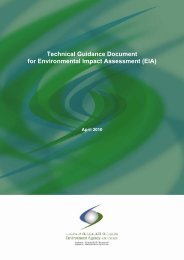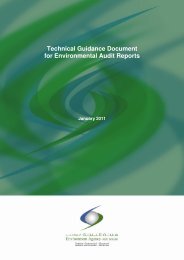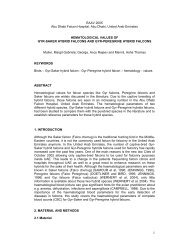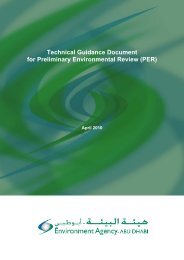Standard Operating Procedure (SOP) for Compliance Monitoring ...
Standard Operating Procedure (SOP) for Compliance Monitoring ...
Standard Operating Procedure (SOP) for Compliance Monitoring ...
You also want an ePaper? Increase the reach of your titles
YUMPU automatically turns print PDFs into web optimized ePapers that Google loves.
<strong>SOP</strong> <strong>for</strong> <strong>Compliance</strong> <strong>Monitoring</strong> Using CEMSs<br />
−<br />
−<br />
Per<strong>for</strong>mance audit—This type of audit is used to check all of the individual CEMS<br />
components and factors affecting the precision and accuracy of monitoring data.<br />
Examples of per<strong>for</strong>mance audits include the following: cylinder gas audit (CGA), relative<br />
accuracy test audit (RATA), and relative accuracy audit (RAA). The RATA is typically<br />
per<strong>for</strong>med by a third party, which brings its own measurement equipment to the site to<br />
per<strong>for</strong>m a side-by-side comparison with the installed equipment, according to the testing<br />
reference method used to determine compliance with the standard.<br />
Systems audit—This type of audit is a systematic qualitative review of facilities,<br />
equipment, training, procedures, record-keeping, validation, and reporting aspects of a<br />
total QA system to determine the system’s capabilities.<br />
Other frequent checks (operational or preventive maintenance) may be required depending on the<br />
CEMS manufacturer’s instructions and the Operator’s experience with the system. The Owner or<br />
Operator should include all additional checks on the daily/weekly/monthly logs. Logs may be either<br />
kept on paper or by computerised records. A useful way to chart the type and frequency of operational<br />
and maintenance checks is to create an activity matrix. The CEMS manufacturer’s manual is useful in<br />
creating this matrix. An example of this type of matrix is presented in Table 3.<br />
Table 3. Example of a CEMS QC Activity Matrix<br />
Activity<br />
Frequency<br />
1. Check system zero and span check results Daily<br />
2. Check cylinder pressures Weekly<br />
3. Check <strong>for</strong> alarms and any malfunction Daily<br />
4. Check components of dilution system on the CEMS (if applicable) Bi-weekly<br />
5. Check filters, desiccants, and dryers As recommended by the manufacturer<br />
6. Conduct per<strong>for</strong>mance audit Quarterly<br />
7. Check shelter temperature of the CEMS Daily<br />
Section II. CEMS <strong>Monitoring</strong> Reports<br />
1. Format and Content of Reports<br />
Emissions Data<br />
Hourly, daily, and annual emissions data should be provided <strong>for</strong> each pollutant. Hourly data <strong>for</strong> each<br />
month should be reported in one data table (i.e., <strong>for</strong> a month with 30 days, there would be 720 hourly<br />
values in one table). Daily data should also be provided in one table (i.e., <strong>for</strong> a month with 30 days,<br />
there would 30 daily values in one table). Annual data should be provided on a spreadsheet, with each<br />
monthly total as one line. There<strong>for</strong>e, a complete report <strong>for</strong> 1 year would have 25 tables as outlined<br />
below:<br />
• 12 hourly tables (one <strong>for</strong> each month), with approximately 720 rows each<br />
• 12 monthly tables, with approximately 30 rows each (one <strong>for</strong> each day)<br />
• 1 annual table, with one line <strong>for</strong> each of the 12 months.<br />
Annex 3 contains an example workbook with spreadsheet templates of the various report tables<br />
oriented towards natural gas-fired power plants <strong>for</strong> the three different time intervals described:<br />
1. Annex 3a—Example of a CEMS Hourly Emissions Report<br />
2. Annex 3b—Example of a CEMS Daily Emissions Report<br />
3. Annex 3c—Example of a CEMS Annual Emissions Report.<br />
As noted in the example of a CEMS hourly emissions report, periods of instrument calibration or<br />
malfunction should be noted in the “Remarks” column. For periods of instrument malfunction or<br />
calibration, values entered into this table should be the average of those in the nearest 4 hours be<strong>for</strong>e<br />
and the nearest 4 hours after instrument malfunction or calibration, provided the plant power during<br />
those hours is equal to the power during instrument malfunction, ±10% of the rated power. Annex 3d<br />
5





